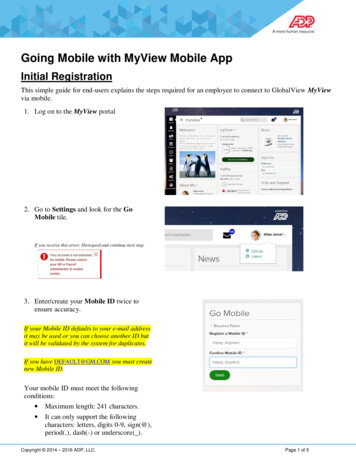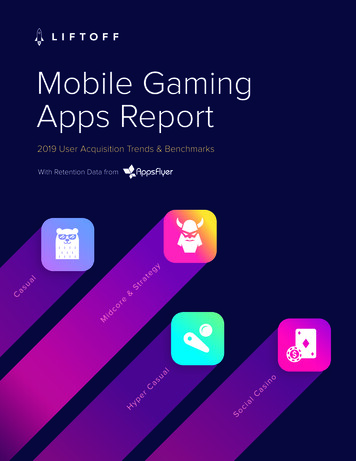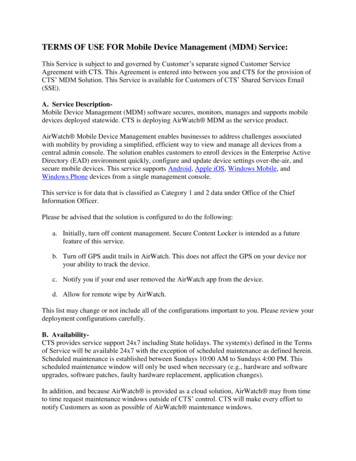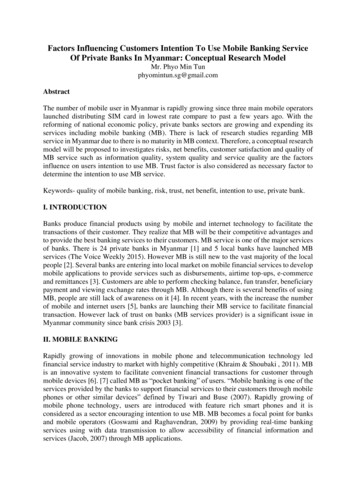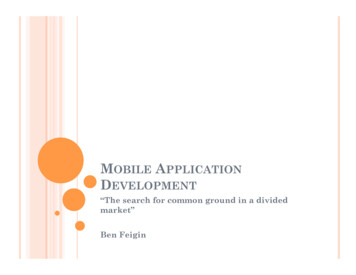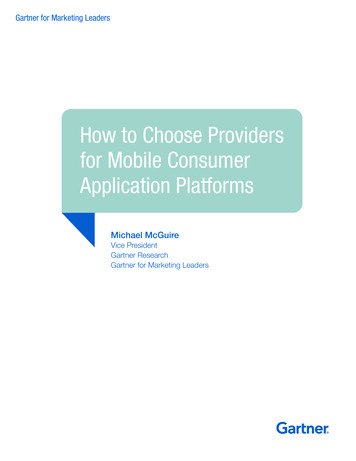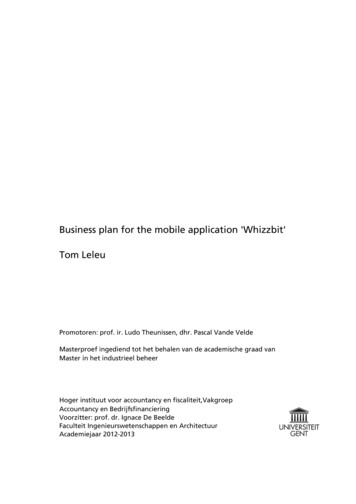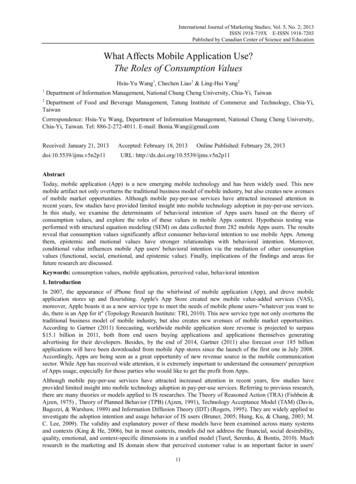
Transcription
International Journal of Marketing Studies; Vol. 5, No. 2; 2013ISSN 1918-719X E-ISSN 1918-7203Published by Canadian Center of Science and EducationWhat Affects Mobile Application Use?The Roles of Consumption ValuesHsiu-Yu Wang1, Chechen Liao1 & Ling-Hui Yang21Department of Information Management, National Chung Cheng University, Chia-Yi, Taiwan2Department of Food and Beverage Management, Tatung Institute of Commerce and Technology, Chia-Yi,TaiwanCorrespondence: Hsiu-Yu Wang, Department of Information Management, National Chung Cheng University,Chia-Yi, Taiwan. Tel: 886-2-272-4011. E-mail: Bonia.Wang@gmail.comReceived: January 21, 2013doi:10.5539/ijms.v5n2p11Accepted: February 18, 2013Online Published: February 28, 2013URL: y, mobile application (App) is a new emerging mobile technology and has been widely used. This newmobile artifact not only overturns the traditional business model of mobile industry, but also creates new avenuesof mobile market opportunities. Although mobile pay-per-use services have attracted increased attention inrecent years, few studies have provided limited insight into mobile technology adoption in pay-per-use services.In this study, we examine the determinants of behavioral intention of Apps users based on the theory ofconsumption values, and explore the roles of these values in mobile Apps context. Hypothesis testing wasperformed with structural equation modeling (SEM) on data collected from 282 mobile Apps users. The resultsreveal that consumption values significantly affect consumer behavioral intention to use mobile Apps. Amongthem, epistemic and motional values have stronger relationships with behavioral intention. Moreover,conditional value influences mobile App users' behavioral intention via the mediation of other consumptionvalues (functional, social, emotional, and epistemic value). Finally, implications of the findings and areas forfuture research are discussed.Keywords: consumption values, mobile application, perceived value, behavioral intention1. IntroductionIn 2007, the appearance of iPhone fired up the whirlwind of mobile application (App), and drove mobileapplication stores up and flourishing. Apple's App Store created new mobile value-added services (VAS),moreover, Apple boasts it as a new service type to meet the needs of mobile phone users-"whatever you want todo, there is an App for it" (Topology Research Institute: TRI, 2010). This new service type not only overturns thetraditional business model of mobile industry, but also creates new avenues of mobile market opportunities.According to Gartner (2011) forecasting, worldwide mobile application store revenue is projected to surpass 15.1 billion in 2011, both from end users buying applications and applications themselves generatingadvertising for their developers. Besides, by the end of 2014, Gartner (2011) also forecast over 185 billionapplications will have been downloaded from mobile App stores since the launch of the first one in July 2008.Accordingly, Apps are being seen as a great opportunity of new revenue source in the mobile communicationsector. While App has received wide attention, it is extremely important to understand the consumers' perceptionof Apps usage, especially for those parties who would like to get the profit from Apps.Although mobile pay-per-use services have attracted increased attention in recent years, few studies haveprovided limited insight into mobile technology adoption in pay-per-use services. Referring to previous research,there are many theories or models applied to IS researches. The Theory of Reasoned Action (TRA) (Fishbein &Ajzen, 1975) , Theory of Planned Behavior (TPB) (Ajzen, 1991), Technology Acceptance Model (TAM) (Davis,Bagozzi, & Warshaw, 1989) and Information Diffusion Theory (IDT) (Rogers, 1995). They are widely applied toinvestigate the adoption intention and usage behavior of IS users (Bruner, 2005; Hung, Ku, & Chang, 2003; M.C. Lee, 2009). The validity and explanatory power of these models have been examined across many systemsand contexts (King & He, 2006), but in most contexts, models did not address the financial, social desirability,quality, emotional, and context-specific dimensions in a unified model (Turel, Serenko, & Bontis, 2010). Muchresearch in the marketing and IS domain show that perceived customer value is an important factor in users'11
www.ccsenet.org/ijmsInternational Journal of Marketing StudiesVol. 5, No. 2; 2013decision processes in pay-per-user service behavior (H. W. Kim, Chan, & Gupta, 2007; Turel, Serenko, & Bontis,2007). Moreover, consumer-behavior literature also shows that perceived value, which may be conceptualizedbefore a product is bought or used, both strongly and stably predicts consumers' purchasing intentions (Eggert &Ulaga, 2002; Sweeney & Soutar, 2001). Thus, seeking the underlying motives or values that drives consumer toadopt, use and consume technology in general and mobile artifacts in particular (Blechar, Constantiou, &Damsgaard, 2006).This study applied the theory of consumption values developed by Sheth et al. (1991a) to investigate the keydeterminants of behavioral intention to employ pay-per-use mobile artifacts, especially for Apps. Theconsumption values include functional, social, emotional, epistemic and conditional values. Most of the earliervalue-based studies employed Sweeney and Souter's (1999) PERVAL as the theoretical foundation, and excludedthe epistemic and conditional values from their investigations (Deng, Lu, Wei, & Zhang, 2010; Y. Lee, Kim, Lee,& Kim, 2002; Turel et al., 2007; Yang & Jolly, 2009), only rare researchers employed these two values as factorsin their researches (Pihlstrom & Brush, 2008; Pura, 2005). Nevertheless, Braiterman and Savio (2007) indicatedthat "context is everything" in mobile interaction, condition-specific value dimension cannot be ignored invalue-based investigation. Therefore, two research questions are investigated in this study. First, we examine thekey value components to drive mobile users' behavioral intentions to use Apps. The next, we explore the roles ofconsumption value in the mobile Apps context.The remainder of the paper is organized as follows. The next section discusses the theoretical background ofvalue. The subsequent section develops a framework of value structure and presents the research hypotheses.The method is described next and the results follow. The paper ends with a discussion of the results,contributions for research and practice, and suggestions for future research.2. Theoretical Background and Hypotheses2.1 Mobile ApplicationA mobile application (or mobile App) is software application that runs on a mobile device (smart phone, tablet,iPod, etc.), and has an operating system that supports standalone software (Wikipedia, 2012). They are availablethrough application distribution platforms, which are typically operated by the owner of the mobile operatingsystem, such as the Apple App Store, Google Play, Windows Phone Store and BlackBerry App World (Siegler,2008). Mobile Apps can come preloaded on the mobile device as well as can be downloaded by users frommobile App stores or the Internet. Moreover, mobile Apps usually help users by connecting them to Internetservices more commonly accessed on desktop or notebook computer, or help them by making it easier to use theInternet on their portable devices.2.2 The Concept of Perceived ValueValue is considered to be an important constituent of relationship marketing and the ability of a company toprovide superior value to its customers is regarded as one of the most successful strategies for the 1990s. Thisability has become a mean of differentiation and a key to the riddle of how to find a sustainable competitiveadvantage (Ravald & Grönroos, 1996). In addition, Holbrook (1994) addressed that "Marketing involvesexchanges; exchanges depend on customer value; therefore, customer value is the fundamental basis for allmarketing activity". Customer perceived value, a strategic imperative for producers and retailers in the 1990s,will be of continuing importance into the twenty-first century (Sweeney & Soutar, 2001; Woodruff, 1997).Consumers purchase not only based on the superior economic or utility value that they obtain, but increasinglybecause of the perceived corporate, social and environmental reputation value of the firm purveying the product,brand or service (Tarn, 1999). Therefore, if consumers are really "value-driven" (Sweeney & Soutar, 2001), thenpractitioners need to understand what customer perceived value and where they should focus their attention toachieve this needed market place advantage (Woodruff, 1997).While customer perceived value has been defined and adapted by a number of different researchers, there aretwo approaches are applied: uni-dimensional and multi-dimensional approaches. The perspective ofuni-dimensional approach consider perceived value to be a cognitive trade-off between benefits and sacrifices(Monroe, 1990). However, in a marketing context, perceived value is not just limited to the functional aspects ofquality and price, but may also include other components (Sheth et al., 1991a). The multi-dimensional constructthat consists of several interrelated attributes or dimensions that form a holistic representation of a complexphenomenon. It means perceived value is a variety of notions (such as perceived price, quality, benefits, andsacrifice) are all embedded (Babin, Darden, & Griffin, 1994; Holbrook, 1994; Sheth, Newman, & Gross, 1991b;Sweeney & Soutar, 2001; Woodruff, 1997). Sheth et al. (1991b) argued that consumer purchase choice entails avariety of forms of value. These forms of value can be categorized as functional, social, emotional, epistemic,12
www.ccsenet.org/ijmsInternational Journal of Marketing StudiesVol. 5, No. 2; 2013and conditional. In addition, Babin et al. (1994) addressed that assessed consumers' evaluations of a purchaseexperience along two dimensions: hedonic and utilitarian values.As prior researchers (e.g. H. W. Kim et al., 2007; Turel et al., 2007) mentioned, the users of information andcommunication technology (ICT) are not only technology users, but also the service consumers. To understandthe behaviors of ICT users can not only considers the technology utilities, but also take other factors into account,such as emotional, psychological, or social factors. Moreover, both the marketing and the IS disciplines haveempirically proved that perceived value is multi-dimensional and can be measured by a variety of instruments(e.g. Pura, 2005; Sweeney & Soutar, 2001). Particularly in mobile technology and service contexts, numerousempirical studies have applied perceived value concept to investigate the mobile technologies adoptions andusage, such as mobile internet (e.g. H. W. Kim et al., 2007), location-based services (e.g. Pura, 2005), or mobiledata services (e.g. B. Kim & Han, 2009; Yang & Jolly, 2009), and find the significant influences of perceivedvalue on customers' adoption or usage behaviors. Consequently, this study utilized the multi-dimensional valueapproach to investigate the antecedents and consequences of mobile Apps use.2.3 Hypotheses DevelopmentAmong these approaches to perceived value, Sheth et al. (1991a) is one of the most important contributions tothe study of perceived value in that the authors define a complex multi-dimensional structure for the concept(Sanchez-Fernandez & Iniesta-Bonillo, 2007). We therefore employ the theory of consumption values to explainthe behavioral intention of Apps use. This theory integrates components from various consumer behavior modelsand assumes that consumer choice is a function of multiple consumption values (Turel et al., 2010); theimportance of this theory lies in positing that consumers balance value assessments for making informed,intrinsically and extrinsically motivated consumption decision (H. W. Kim et al., 2007). Sheth et al. (1991b)argued that a customer purchase choice was influenced by a multiple consumption value dimension (functional,emotional, social, epistemic, and conditional value), and different dimensions have different roles in the user’sdecision (Deng et al., 2010). Thus, the TCV is more applicable to explain individual consumption behavior. Inthe present study, we propose the framework of a value structure composed of different types of values forexploring the behavioral intention to use Apps by using the theory of consumption values. The research model isestablished as shown in Figure 1.2.3.1 Functional ValueFunctional value concerns the utilitarian functions and services that a product can offer. The value is oftenmanifested through a product's composite attributes such as qualities or features that can deliver impressions ofutilitarian performance(Tzeng, 2011). According to Sheth et al. (1991a), functional value pertains to the abilityof product to perform its functional, utilitarian, or physical purpose and while it may be based on any salientphysical attribute, sometimes price is the most salient functional value. In IS and mobile service contexts,functional value have empirically proven that positively affect users' behavioral intentions to use informationsystems (e.g. Cheng, Wang, Lin, & Vivek, 2009; Tzeng, 2011), or mobile services (e.g. Pura, 2005; Turel et al.,2007; Yang & Jolly, 2009). Mobile App is a new ICT artifact. Mobile App is an information software, and canprovide mobile service to satisfy mobile users' needs. Hence, the function value of mobile App is expected topositively influence users' behavioral intention to use mobile Apps. The hypothesis is also proposed.H1. Functional value positively affects the behavioral intention to use mobile micValue(EPV)Figure 1. Research model13BehavioralIntention to Use(BI)
www.ccsenet.org/ijmsI
This theory integrates components from various consumer behavior models and assumes that consumer choice is a function of multiple consumption values (Turel et al., 2010); the importance of this theory lies in positing that consumers balance value assessments for making informed,




